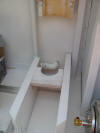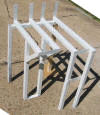
Fill the space - manage the weight
The original concept for mounting the cylinders was based on a rectangular steel tubing framework. That evolved to using uni-strut rather than plain tubing. After staring at it for a while, it ended up a hybrid of steel tubing, strut, wood and strapping.
The steel frames provided the gross support, but didn't offer a clear way to "snug" the cylinders into the framework. After becoming familiar with package strapping, bought initially to secure the water heaters, it seemed like this might be the ideal fastener for the cylinders as well.
If the strapping doesn't seem to work out over time, it will be replaced with stainless steel band clamps. These clamps were hard to find, but they are manufactured by Breeze Industrial Products. The band material is sold in kits/rolls, available through resellers, and is cut to length and the worm gear fastening mechanism is added.
After tweaking the tank design to compensate for the gray water tank and furnace ducting, we ended up with a combination of cylinder sizes to maximize water capacity.
Vertical wooden rails/cradle provide secure contact with cylinder bodies and are bound with steel bands. The vertical rails provide horizontal stability. A strut framework provides additional lateral stability.
Two full-height cylinders each hold about 22 gallons and weigh about 225 pounds. These are supported, vertically, with wooden rails on the floor. The four smaller tanks each hold about 14 gallons and weigh 150 pounds. These are supported vertically by a welded steel frame. Below is a picture of the frame in construction and complete.
The three cylinders against the wall are strapped into cradles mounted on the wall. Below are pictures of the cradles.
The cylinders are secured to the cradles by stainless steel band clamps running through grooves in the back of the cradles. The grooves were rounded on the corners. An attempt was made to use the poly strapping material used for package banding, but the shape of the cylinders and tight quarters made it impossible to properly tension and crimp the strapping. The large band clamps came from McMaster-Carr, and were sold as a coil of the band material, which is cut to length, and the worm drive tensioning mechanism added. The first continuous banding system I selected was unsatisfactory. The band itself was solid, which seemed strong, but the worm screw clamp mechanism didn't allow adequate tensioning. I ended up with a perforated band with a clamp/tightening device that hooked into the perorated band. I later used the first band material to secure heat shields to the chassis, to protect cables and hoses from the exhaust system heat.
The rear cylinders are fastened directly to the wall-mounted cradles. A flat, 3/4" panel separates the rear and outside cylinders. This panel has vertical "chocks" to lock the cylinders from lateral movement. The panel is braced the side walls for support.




